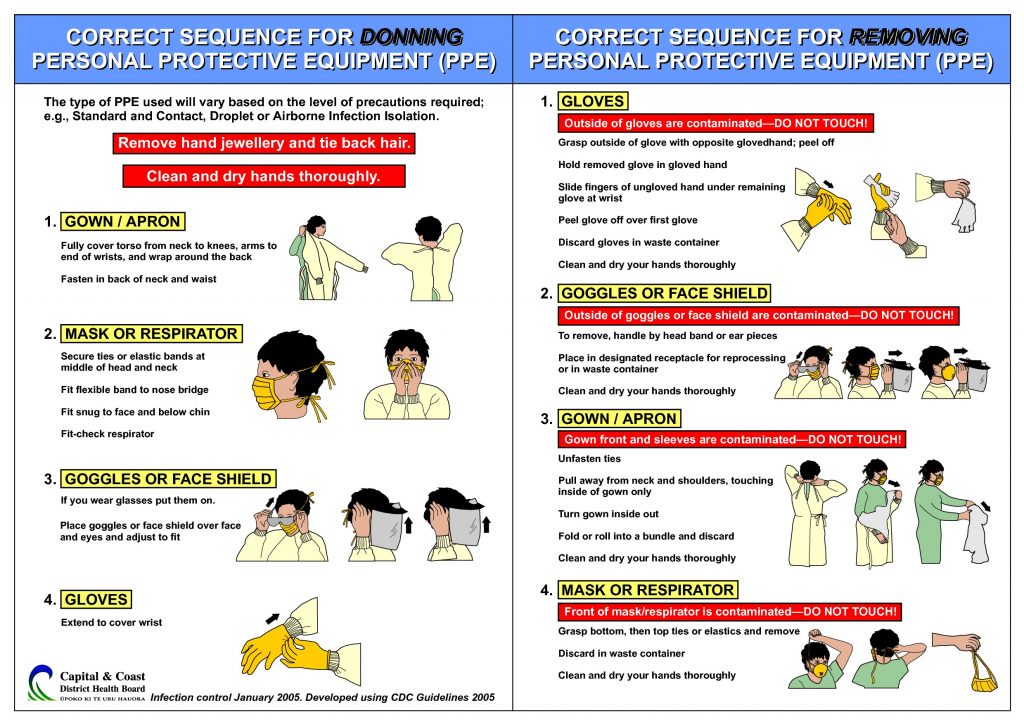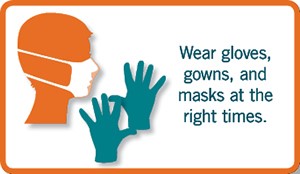Standard Precautions. Personal Protective Equipment.
Standard Precautions. Personal Protective Equipment.
Standard precautions.
Standard precautions are the minimum infection prevention practices that should be used in the care of all patients/clients all of the time. These practices are designed to both protect the healthcare worker and to prevent the healthcare worker from spreading infections among patients.
Standard precautions include:
- Hand hygiene,
- Use of personal protective equipment (e.g., gloves, gowns, masks),
- Safe injection practices,
- Safe handling of potentially contaminated equipment or surfaces in the patient environment, and
- Respiratory hygiene/cough etiquette.

Isolation precautions.
Isolation precautions are used to help stop the spread of germs from one person to another. These precautions protect patients, families, visitors, and healthcare workers from the spread of germs.

Generally, when patients are placed on isolation precautions, there will be a sign at the door of their hospital rooms to remind visitors and healthcare workers which isolation precautions are needed. All healthcare workers and visitors need to follow these guidelines. Healthcare workers should not eat or drink in isolation rooms and should always clean their hands before entering the room and upon exiting the room.
Transmission based.
Contact Isolation Precautions—used for infections, diseases, or germs that are spread by touching the patient or items in the room (examples: MRSA, VRE, diarrheal illnesses, open wounds, RSV).
Healthcare workers should:
- Wear a gown and gloves while in the patient’s room.
- Remove the gown and gloves before leaving the room.
- Clean hands (hand washing or use hand sanitizer) when entering and leaving the room.
- Visitors must check with the nurse before taking anything into or out of the room.
Droplet/airborne precautions.
Droplet Isolation Precautions—used for diseases or germs that are spread in tiny droplets caused by coughing and sneezing (examples: pneumonia, influenza, whooping cough, bacterial meningitis).
Healthcare workers should:
- Wear a surgical mask while in the room. Mask must be discarded in trash after leaving the room.
- Clean hands (hand washing or use hand sanitizer) when they enter the room and when they leave the room.
Airborne Isolation Precautions—used for diseases or very small germs that are spread through the air from one person to another (examples: Tuberculosis, measles, chickenpox).
Healthcare workers should:
- Ensure patient is placed in an appropriate negative air pressure room (a room where the air is gently sucked outside the building) with the door shut.
- Wear a fit-tested NIOSH-approved N-95 or higher level respirator while in the room. Mask must be discarded in trash after leaving the room.
- Clean hands (hand washing or use hand sanitizer) when they enter the room and when they leave the room.
- Ensure the patient wears a surgical mask when leaving the room.
- Instruct visitors to wear a mask while in the room.
Respiratory hygiene/cough etiquette.
Respiratory hygiene and cough etiquette are infection prevention measures to decrease the transmission of respiratory illness such as influenza or cold viruses in healthcare facilities where patients, clients, employees, and visitors may not be immediately recognized as having a respiratory infection. These measures are part of the standard precautions that should be taken to prevent the spread of disease. Important elements include:
- Education of patients, families, visitors, clients and care providers about how respiratory infections are transmitted and how respiratory illness can be prevented. Ask family members, visitors, and care providers to stay home if they are sick.
- Use of posted signs with instructions and pictures about how to cover your cough and wash your hands.
- Availability and use of tissues when coughing and sneezing, and reminders to dispose of used tissues properly.
- Use of a mask for a person who is coughing.
- Physical separation of the person with a respiratory infection from others.
- Stressing hand hygiene after contact with respiratory secretions. This applies to the patient, family members, visitors, employees, and care providers.
- Nosocomial infection (Hospital acquired infection): It is an infection acquired from health care settings. It may be exogenous infection when part of the client’s flora become altered and an over growth results.
Nosocomial infections.
- Nosocomial infection (Hospital acquired infection): It is an infection acquired from health care settings. It may be exogenous infection when part of the client’s flora become altered and an over growth results.
Vaccination can prevent Hepatitis B infection.
- Hepatitis B Virus (HBV) is a viral infection of the liver. The disease causes fatigue, mild fever, muscle and joint pain, nausea, vomiting, and loss of appetite. There is no known cure for HBV at this time. HBV usually spreads through contact with infected blood, blood products, body fluids, or anywhere blood is present.